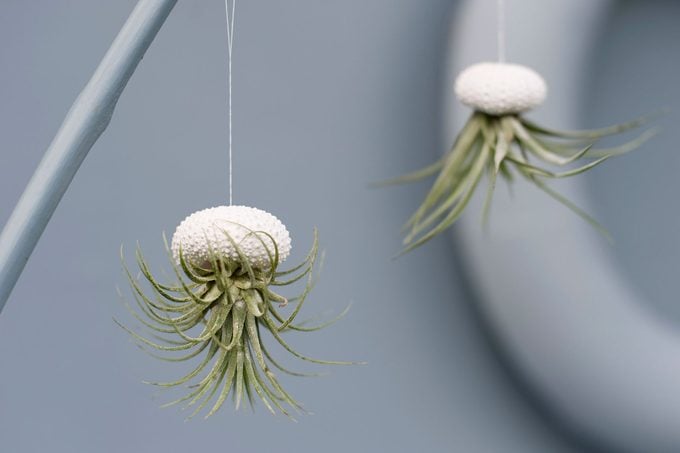Everything You Need to Know About Air Plants
Updated: Oct. 16, 2023

Air plants are the super cool, spiky rosettes you see in hanging bowls or on driftwood at garden stores. They don't need soil, making them the perfect addition to low-maintenance indoor gardens.
The air plant (tillandsia), as its name suggests, has a reputation for living on air. Technically, they don’t float, but they do absorb what they need through their pointy, sometimes swirly, leaves rather than their roots.
In the wild, you may find them attached to tree branches or in patches of root below. Their architectural rosette is unlike soil-bound plants and adds visual flair for indoor gardeners. Despite having roots in the tropics, they can basically grow wherever the light and temperature support them, inside or out. Not only are they included in the great air-purifying plants for your home, but they are also among the easiest-to-grow houseplants.
What Are Air Plants?

Air plants are part of the Bromeliaceae or Bromeliad family. There are hundreds of varieties in shades of gray, green, rose or coral (these are some of our favorite air plants!). They’re categorized as epiphytes, meaning they live above ground and receive all of the moisture they need from rainfall and humidity in the air.
Nutrition will come from the atmosphere or a host plant as well. That means they can thrive wherever they find a perch and don’t need soil to do so. With the correct conditions, they will bloom but only once. It’s a necessary part of their lifecycle after which they can propagate by throwing “pups.” They live between two and five years, but the offshoots can perpetuate an air plant.
How to Care for Air Plants

Despite their sometimes dusty appearance and their reputation of ease, air plants do have a few specific growing requirements.
Planting Air Plants
In nature, air plants attach where they land with the help of their shallow roots. In a house, planting is more like styling. There is only one rule: avoid soil. They can be placed in a bowl with pebbles, attached with moss and fishing line to an orchid with its similar growing conditions or added to driftwood. Use your imagination and current decor to guide display choices; you can even group a few together for a bolder look. Wherever you decide, just ensure they can be easily removed from their support for watering.
Watering Air Plants
If you’re cultivating air plants at home, be mindful of their water requirements. There are a couple of ways to give them what they need. Misting them fully two to three times per week can work, but a complete bath is preferable. Immerse it in water once a week for at least 30 minutes. (Avoid chemically softened water!) Shake out excess water before returning your air plant to its home. The best time to water plants is in the morning. When air plants have damp leaves at night it will be more challenging for them to absorb carbon dioxide.
The Best Air Plant Environment
For healthy air plants, try to channel their tropical heritage. They prefer bright, dappled light and warm, well-circulated air. Avoid placing them in temperatures that drop below 50°F, but they’re fine with a cooldown at night. In homes that experience winter, keep them away from super cold window exposure.
